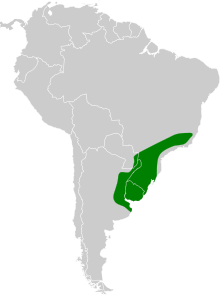| Diademed tanager | |
|---|---|

| |
| Scientific classification | |
| Domain: | Eukaryota |
| Kingdom: | Animalia |
| Phylum: | Chordata |
| Class: | Aves |
| Order: | Passeriformes |
| Family: | Thraupidae |
| Genus: | Stephanophorus Strickland, 1841 |
| Species: | S. diadematus
|
| Binomial name | |
| Stephanophorus diadematus (Temminck, 1823)
| |

| |
| Synonyms | |
|
Tanagra diademata (protonym) | |
The diademed tanager (Stephanophorus diadematus) is a species of Neotropical bird in the tanager family Thraupidae. It is the only member of the genus Stephanophorus. It is purple-blue with a white crown characterised by a small red patch, and it is found mostly in open areas in southern Brazil, northeast Argentina, and Uruguay.
Taxonomy
The diademed tanager was formally described and illustrated in 1823 by the Dutch zoologist Coenraad Jacob Temminck under the binomial name Tanagra diademata.[2] The type locality is Curitiba in Brazil.[3] This is now the only species placed in the genus Stephanophorus that was introduced in 1841 by the English naturalist Hugh Edwin Strickland.[4][5] The genus name combines the Ancient Greek stephanē meaning "diadem" and -phoros meaning "carrying". The specific epithet diadematus is Latin meaning "diademed".[6] The diademed tanager is monotypic: no subspecies are recognised.[5]
References
- ^ BirdLife International (2016). "Stephanophorus diadematus". IUCN Red List of Threatened Species. 2016: e.T22722656A94776696. doi:10.2305/IUCN.UK.2016-3.RLTS.T22722656A94776696.en. Retrieved 12 November 2021.
- ^ Temminck, Coenraad Jacob (1838) [1823]. Nouveau recueil de planches coloriées d'oiseaux, pour servir de suite et de complément aux planches enluminées de Buffon (in French). Vol. 3. Paris: F.G. Levrault. Plate 257, Livraison 41. The 5 volumes were originally issued in 102 livraisons (parts), 1820-1839. For the publication date see: Dickinson, E.C. (2001). "Systematic notes on Asian birds. 9. The Nouveau recueil de planches coloriées of Temminck & Laugier (1820–1839)". Zoologische Verhandelingen, Leiden. 335: 7–53.
- ^ Paynter, Raymond A. Jr, ed. (1970). Check-List of Birds of the World. Vol. 13. Cambridge, Massachusetts: Museum of Comparative Zoology. p. 336.
- ^ Strickland, Hugh Edwin (1841). "On some new genera of birds". Proceedings of the Zoological Society of London. Part 9: 27–34 [30–31].
- ^ a b Gill, Frank; Donsker, David; Rasmussen, Pamela, eds. (July 2020). "Tanagers and allies". IOC World Bird List Version 10.2. International Ornithologists' Union. Retrieved 1 November 2020.
- ^ Jobling, James A. (2010). The Helm Dictionary of Scientific Bird Names. London: Christopher Helm. pp. 134, 365. ISBN 978-1-4081-2501-4.
External links

